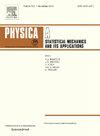Uncertainty driven decision making and perturbation dynamics in evolutionary games on small-world networks
IF 3.1
3区 物理与天体物理
Q2 PHYSICS, MULTIDISCIPLINARY
Physica A: Statistical Mechanics and its Applications
Pub Date : 2025-06-09
DOI:10.1016/j.physa.2025.130719
引用次数: 0
Abstract
The efficiency of models that aim to interpret real world scenarios largely depends on how well they can reproduce empirical data. However, this task is challenged by uncertainties arising from dynamic environments. Recent studies on feedback-evolving games which characterize the interplay between the evolution of strategies and environmental changes, provide a theoretical framework to address this uncertainty problem. While previous studies assumed uncertainty caused by dynamic environments would impact all decisions equally, the proposed model reveals that decision-specific uncertainty influences the behavioral dynamics of a population differently. By introducing uncertainty as perturbations to a 2 × 2 payoff structure, the proposed model represents different aspects of real world uncertainty. This study reveals that perturbations applied to the off diagonal elements promote coexistence among strategies, whereas perturbations spanning the entire payoff matrix enhance cooperative behaviors. In contrast, perturbations introduced through the main diagonal and cost–benefit terms drive the system towards defective behavior. It is also evident that those findings remain consistently across various network structures. Expanding upon these findings, the study was extended to small-world networks, investigating the impact of key parameters such as the average degree (number of neighbors) and rewiring probability. Our results uncover intricate dependencies between these structural parameters and behavioral dynamics over time under various perturbation mechanisms. Overall, this research provides a comprehensive understanding of how external dynamics and network structures collectively shape evolutionary dynamics while highlighting the role of game transitions in evolutionary dynamics.
小世界网络进化博弈中的不确定性驱动决策和扰动动力学
旨在解释现实世界情景的模型的效率在很大程度上取决于它们能多好地再现经验数据。然而,这一任务受到动态环境产生的不确定性的挑战。最近关于反馈进化博弈的研究(游戏邦注:该研究描述了策略进化与环境变化之间的相互作用)为解决这一不确定性问题提供了理论框架。以往的研究假设动态环境引起的不确定性对所有决策的影响是相同的,而本文提出的模型揭示了决策特定的不确定性对群体行为动力学的影响是不同的。通过将不确定性作为扰动引入2 × 2收益结构,所提出的模型代表了现实世界不确定性的不同方面。研究表明,非对角线元素的扰动促进了策略间的共存,而跨越整个支付矩阵的扰动则增强了合作行为。相反,通过主对角线和成本-收益项引入的扰动将系统推向有缺陷的行为。同样明显的是,这些发现在不同的网络结构中保持一致。在这些发现的基础上,研究扩展到小世界网络,调查了关键参数的影响,如平均程度(邻居数量)和重新布线概率。我们的研究结果揭示了在各种扰动机制下,这些结构参数和行为动力学之间随时间的复杂依赖关系。总体而言,本研究提供了对外部动力和网络结构如何共同塑造进化动力的全面理解,同时强调了游戏转变在进化动力中的作用。
本文章由计算机程序翻译,如有差异,请以英文原文为准。
求助全文
约1分钟内获得全文
求助全文
来源期刊
CiteScore
7.20
自引率
9.10%
发文量
852
审稿时长
6.6 months
期刊介绍:
Physica A: Statistical Mechanics and its Applications
Recognized by the European Physical Society
Physica A publishes research in the field of statistical mechanics and its applications.
Statistical mechanics sets out to explain the behaviour of macroscopic systems by studying the statistical properties of their microscopic constituents.
Applications of the techniques of statistical mechanics are widespread, and include: applications to physical systems such as solids, liquids and gases; applications to chemical and biological systems (colloids, interfaces, complex fluids, polymers and biopolymers, cell physics); and other interdisciplinary applications to for instance biological, economical and sociological systems.

 求助内容:
求助内容: 应助结果提醒方式:
应助结果提醒方式:


